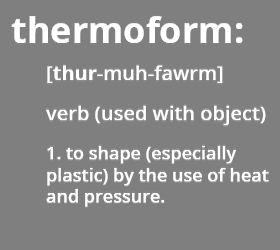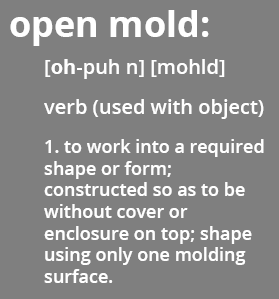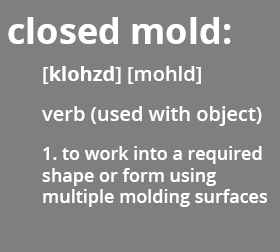Production Capabilities
Thermoforming
Thermoforming is the controlled heating of a thermoplastic material to a particular processing temperature so that when force is applied, it replicates the shape of the mold. The force can be vacuum pressure, air pressure or direct mechanical force to the pliable thermoplastic.
Vacuum Forming requires the heating of a thermoplastic until it reaches its forming temperature then applying a vacuum to form it into or around a mold.
Drape Forming requires the heating of a thermoplastic until it reaches its forming temperature then applying a mechanical force to form it into or around a mold.
Pressure Forming is a sophisticated version of the vacuum forming process that uses air pressure as a forming aid to increase the detail on the mold side. Resulting is a product with the appearance of an injection molded part for a vacuum formed price.


Open Mold (Fiberglass)
Open Mold is the most commonly used method of manufacturing fiber reinforced polymer (FRP) composites. In open molding, a one-sided mold is used where the cosmetic surface is directly against the mold, the gel coat, is typically first applied to the mold and the structural FRP is built up behind the cosmetic surface (the gel coat).
Hand lay-up (HLU) is the simplest and oldest open mold method of the composite fabrication processes. It is a low volume, labor intensive method. Typically glass mat or other reinforcing mat or woven fabric or roving is positioned manually in the open mold, and resin is poured, brushed, or sprayed over the reinforcement. Air is removed manually with squeegees or rollers to complete the laminate structure.
Spray-Up (SU) is an open mold method that can produce parts more economically than hand lay-up. Chopped fiberglass reinforcement and catalyzed resin, and in some cases, filler materials, are deposited on the mold surface from a combination chopper/spray gun. Rollers or squeegees are used to manually remove entrapped air and work the resin into the reinforcements.
Closed Mold (Fiberglass)
Light Resin Transfer Molding (LRTM) is a closed mold system that consists of an “A” side mold and a semi-rigid “B” side mold or counter tool. A laminate structure is created from fiber reinforcements that are placed on the, typically gel coated, “A” side mold which is then covered with the “B” side counter tool, the mold halves are sealed using vacuum and then catalyzed resin is drawn or pumped into the mold through ports generally incorporated in the counter tool. When the resin is cured, the counter tool is removed and the part is de-molded.
Bag Molding is a closed mold system that consists of an “A” side mold and a flexible, reuseable “B” side mold or counter tool made from silicone, latex or other flexible-like products. Like other closed mold processes, the “A” side mold is layered with fiberglass, the flexible counter mold is placed on top and a vacuum is applied to seal the tools together. Catalyzed resin is drawn or pumped in to the tool cavity until filled. The resin is allowed to cure and the bag is removed.
Vacuum Infusion Process (VIP) is a closed mold system that consists of an “A” side mold and a disposable this bagging as its “B” side mold or counter tool. Specialty reinforcements are used to build the laminate, with bleeder cloth and bagging film used to sealed onto the “A” side mold. A vacuum is pulled through ports in the bagging film and catalyzed resin is pulled into the mold cavity based on the level of vacuum pressure.

